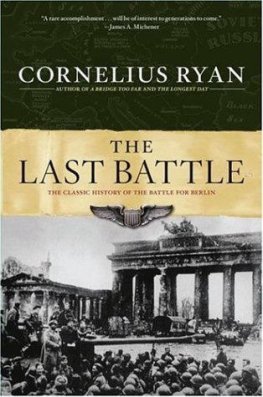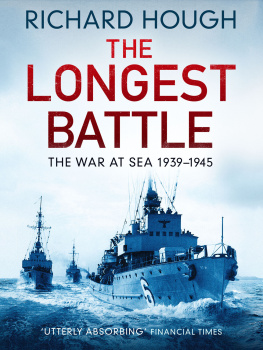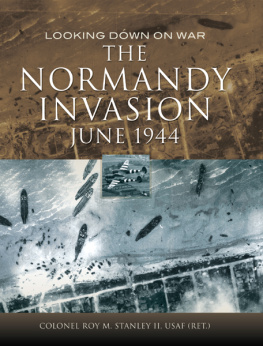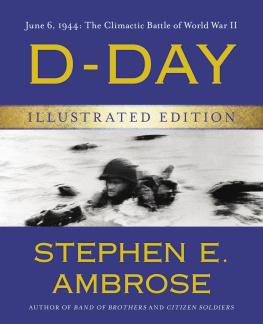
BY CORNELIUS RYAN
A BRIDGE TOO FAR - 1974
THE LAST BATTLE - 1966
THE LONGEST DAY - 1959


SIMON & SCHUSTER PAPERBACKS
Rockefeller Center
1230 Avenue of the Americas
New York, New York 10020
www.SimonandSchuster.com
Copyright 1959 by Cornelius Ryan
Copyright renewed 1987 by Kathryn Morgan Ryan, Victoria Ryan Bida and Geoffrey J. M. Ryan
All rights reserved, including the right of reproduction in whole or in part in any form.
SIMON & SCHUSTER PAPERBACKS and colophon are registered trademarks of Simon & Schuster, Inc.
For information about special discounts for bulk purchases, please contact Simon & Schuster Special Sales: 1-800-456-6798 or business@simonandschuster.com.
Designed by Irving Perkins Associates
Manufactured in the United States of America
30 29 28 27
Library of Congress Catalog Card Number: 59009499
ISBN-13: 978-0-671-89155-8
eISBN-13: 978-1-439-12646-2
ISBN-10: 0-671-89155-3
ISBN-13: 978-0-671-89091-9 (Pbk)
ISBN-10: 0-671-89091-3 (Pbk)
Lines from the song I Double Dare You copyright MCMXXXVII by Shapiro, Bernstein & Co., Inc., New York. By permission of the publisher.
Portions of this book appeared originally in Readers Digest.
FOR ALL THE MEN OF D DAY
Contents

PART ONE
THE WAIT
PART TWO
THE NIGHT
PART THREE
THE DAY
Believe me, Lang, the first twenty-four hours of the invasion will be decisive the fate of Germany depends on the outcome for the Allies, as well as Germany, it will be the longest day.
Field Marshal Erwin Rommel to his aide, April 22, 1944
Foreword: D Day, Tuesday, June 6, 1944

OPERATION OVERLORD, the Allied invasion of Europe, began at precisely fifteen minutes after midnight on June 6, 1944in the first hour of a day that would be forever known as D Day. At that moment a few specially chosen men of the American 101st and 82nd airborne divisions stepped out of their planes into the moonlit night over Normandy. Five minutes later and fifty miles away a small group of men from the British 6th Airborne Division plunged out of their planes. These were the pathfinders, the men who were to light the dropping zones for the paratroopers and glider-borne infantry that were soon to follow.
The Allied airborne armies clearly marked the extreme limits of the Normandy battlefield. Between them and along the French coastline lay five invasion beaches: Utah, Omaha, Gold, Juno and Sword. Through the predawn hours as paratroopers fought in the dark hedgerows of Normandy, the greatest armada the world had ever known began to assemble off those beachesalmost five thousand ships carrying more than two hundred thousand soldiers, sailors and coastguardmen. Beginning at 6:30 A.M. and preceded by a massive naval and air bombardment, a few thousand of these men waded ashore in the first wave of the invasion.
What follows is not a military history. It is the story of people: the men of the Allied forces, the enemy they fought and the civilians who were caught up in the bloody confusion of D Daythe day the battle began that ended Hitlers insane gamble to dominate the world.
PART ONE
 THE WAIT
THE WAIT1

THE VILLAGE WAS silent in the damp June morning. Its name was La Roche-Guyon and it had sat undisturbed for nearly twelve centuries in a great lazy loop of the Seine roughly midway between Paris and Normandy. For years it had been just a place that people passed through on their way to somewhere else. Its only distinction was its castle, the seat of the Dukes de La Rochefoucauld. It was this castle jutting out from the backdrop of hills behind the village that had brought an end to the peace of La Roche-Guyon.
On this gray morning the castle loomed up over everything, its massive stones glistening with dampness. It was almost 6:00 A.M., but nothing stirred in the two great cobbled courtyards. Outside the gates the main road stretched broad and empty, and in the village the windows of the red-roofed houses were still shuttered. La Roche-Guyon was very quietso quiet that it appeared to be deserted. But the silence was deceptive. Behind the shuttered windows people waited for a bell to ring.
At 6:00 A.M. the bell in the fifteenth-century Church of St. Samson next to the castle would sound the Angelus. In more peaceful days it had had a simple meaningin La Roche-Guyon the villagers would cross themselves and pause for a moment of prayer. But now the Angelus meant much more than a moment of meditation. This morning when the bell rang it would mark the end of the nights curfew and the beginning of the 1,451st day of German occupation.
Everywhere in La Roche-Guyon there were sentries. Huddled in their camouflage capes, they stood inside both gates of the castle, at road blocks at each end of the village, in pillboxes built flush into the chalk outcroppings of the foothills and in the crumbling ruins of an old tower on the highest hill above the castle. From up there machine gunners could see everything that moved in this, the most occupied village in all of occupied France.
Behind its pastoral front La Roche-Guyon was really a prison; for every one of the 543 villagers, in and around the area there were more than three German soldiers. One of these soldiers was Field Marshal Erwin Rommel, commander in chief of Army Group B, the most powerful force in the German west. His headquarters was in the castle of La Roche-Guyon.
From here in this crucial fifth year of World War II, a tense, determined Rommel prepared to fight the most desperate battle of his career. Under his command more than a half a million men manned defenses along a tremendous length of coastlinestretching almost eight hundred miles, from the dikes of Holland to the Atlantic-washed shores of the Brittany peninsula. His main strength, the Fifteenth Army, was concentrated about the Pas-de-Calais, at the narrowest point of the Channel between France and England.
Night after night, Allied bombers hit this area. Bomb-weary veterans of the Fifteenth Army bitterly joked that the place for a rest cure was in the zone of the Seventh Army in Normandy. Hardly a bomb had fallen there.
For months, behind a fantastic jungle of beach obstacles and mine fields, Rommels troops had waited in their concrete coastal fortifications. But the blue-gray English Channel had remained empty of ships. Nothing had happened. From La Roche-Guyon, on this gloomy and peaceful Sunday morning, there was still no sign of the Allied invasion. It was June 4, 1944.
Next page










